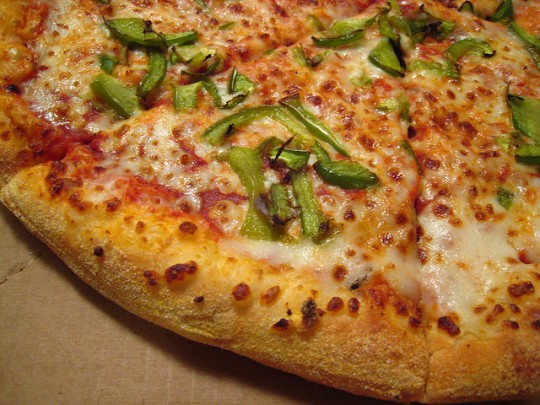The final Obamacare regulation forcing restaurant chains to display calorie information is causing headaches for companies that say it is "impossible to comply" with the new rule.
Domino’s Pizza, one of the regulation’s most outspoken critics, said the rule from the Food and Drug Administration (FDA) is vaguely written and carries the possibility of jail time.
"Essentially we think this rule is a kind of disaster for everybody," Lynn Liddle, executive vice president of Domino’s, told the Washington Free Beacon. "Not just pizza but restaurants, and anybody that’s going to fall within this law. It’s still not workable."
One problem, Liddle said, is that the final rule broadly expanded the definition of what qualifies as a "menu." Under the rule "menu" can refer to any writing that "used by a customer to make an order selection at the time the customer is viewing the writing," which could apply to advertisements.
"We no longer know what a menu is," Liddle said. "It’s really hard to interpret. Essentially they’re saying anything that a consumer can look at and make a potential ordering decision from is a menu." She said this could apply to flyers, ads in the newspapers, or signs in the window.
"If you take it to the broadest thing it could be an ad on the television," she said. "That makes it literally impossible to comply."
Liddle said that the company agrees with the regulation’s goals and has been providing calorie information for more than a decade. The company already offers an online "cal-o-meter" that allows consumers to see the total calories of any pizza they order.
A problem specific to pizza chains is the challenge of displaying a vast number of possible calorie totals across all of the materials that the rule potentially counts as a "menu." Considering that Domino’s customers can customize their own pizzas, there is an endless number of possible combinations of toppings, each of which has a different calorie count. Liddle said a low-ball estimate of combinations Domino’s offers is 34 million. Pizza Hut has 2 billion possible combinations.
"Inherently, we’re not against this. We’re for it," Liddle said. "We’re for giving our customers information that they want and need. So if our customers want calorie information, then we will give it to them--and we do give it to them."
"We just want to do it in a way that makes sense," she said.
Despite the fact that the rule runs 391 pages and addresses details such as whether a limited-time "pumpkin spice muffin" should be covered, it still does not give clear guidance about how restaurants are supposed to comply, according to critics. The rule, finalized in November, will affect chains with 20 or more stores.
"Unfortunately once the sausage was made and all the stuff was finalized, it got homogenized into something that the FDA felt was feasible for everybody," Liddle said. "So they tried to force it into a one-size-fits-all, and I think that’s where the problem began. It really should have been let every brand do it in a way that suits their customers."
The FDA has said it will issue guidance on compliance for companies before the rule goes into effect in December 2015.
Though the regulation remains vague on who is responsible for ensuring that calorie information is displayed, it carries criminal and civil penalties.
"They say there could be civil and criminal penalties for having incorrect calorie information," Liddle said. "And not only is that frightening, that is also very unclear and invites a whole host of potential problems not just for pizza, but for anybody that I can think of who is preparing food and selling it to the public."
"You can go to jail, according to the way this is written, if somehow you did it wrong," she said.
The final rule explains that failure to comply with the regulation will render food "misbranded" under the Food Drug & Cosmetic Act (FD&C Act), which carries criminal penalties.
Violations of the law carry a maximum $1,000 fine, one year in prison, or both. If a person is convicted of a violation, a second violation can carry a $10,000 fine and up to three years in prison.
According to the law, the U.S. government can also seize misbranded food.
While technically the act carries civil and criminal penalties, it is not likely that restaurant owners will find themselves in jail, given the FDA’s approach to enforcement.
"The goal of the FDA is to work with industry on menu-vending machine labeling," said Jennifer Dooren, a press officer for the FDA.
"The first step for the agency in helping ensure compliance will be to provide guidance and technical support materials to the industry," she said. "Before the rules become effective, we intend to issue such materials and further reach out to industry. We also intend to further coordinate with states and local governments."
Dooren added that the government could bring a civil action in federal court over violations of the FD&C Act.
"The FDA will determine the level of monitoring needed depending on our initial assessment of the degree of compliance and available resources," Dooren said. "Enforcement will be considered on a case-by-case basis depending on the specific facts and circumstances."
Even if fines are not issued, the regulation is costly. Liddle said Domino’s does not have an estimate of what compliance will cost her company, though implementing a similar law in New York cost as much as $5,000 per store. The regulation is expected to cost industry $1.7 billion overall.
Domino’s is not going to stop pushing back against the regulation, and is hopeful that Congress or the FDA will revise the rule to make it easier to comply.
"We’re going to continue to fight," Liddle said. "We’re going to try hard not to get issue fatigue, because we’ve been working on this for a long time.
"Hope springs eternal. I still believe that somebody will listen to common sense."
